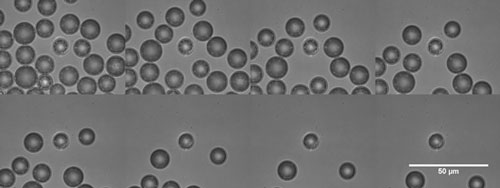| Posted: Jan 28, 2016 |
Trapping microbubbles with lasers and sound
(Nanowerk News) The National Physical Laboratory (NPL) has worked with University College London (UCL) and the University of Oxford to develop an innovative system that can trap microbubbles. This enables scientists to study the bubbles' properties and develop safer, more effective medical products.
|
|
Microbubbles are gas bubbles that are smaller than 1 mm in size - their radius is typically between 1 and 10 microns for medical applications. In the past 10 years, the use of microbubbles to enhance contrast in ultrasound images has become an everyday practice in hospitals in UK and across the world. Microbubbles now sit at the forefront of techniques used for the diagnosis of heart diseases and certain types of cancer.
|
 |
| Video frames of acoustically trapped bubbles and one optically trapped bubble (centre in all images) which is manipulated away from the cloud
|
|
New technological advances, and recent successes in treatment have shown that the addition of certain molecules to the shell of these bubbles could make them ideal vehicles for targeted medicine delivery and microsurgery.
|
|
As the potential applications increase, it becomes more important to characterise how microbubbles interact with sound and how different manufacturing techniques impact on their performance. Information about the microbubble properties can be used to engineer bubbles for specific medical uses, and in a more cost-effective way.
|
|
Scientists from NPL have worked with UCL and the University of Oxford to develop a controlled setting in which to study microbubbles. The unique device, which was designed and constructed at NPL, traps the microbubbles using optical tweezers in combination with acoustic tweezers, which control the movement of objects using sound waves.
|
|
While these two techniques are commonly used for solid particles, they both present challenges when used with bubbles. Optical tweezers, for instance, are often used to trap and study biological samples using highly-focused laser beams to hold and move items. However, objects with a low refractive index, such as microbubbles, are difficult to optically trap due to strong repulsive forces experienced in proximity to high intensity light.
|
|
Bubbles also present a peculiar response to acoustical tweezing, behaving in different ways depending on the selected manipulation frequency. If the acoustic field is higher than the bubbles natural frequency they will move to where the field is strongest in pressure, but if the field is lower than the natural frequency the bubbles will collect at the weakest point.
|
|
This method will allow researchers to perform characterization at the single bubble level and support the development of medical microbubbles. Fully characterised bubbles may even act as stand-alone sensors, for stratified medicine purposes.
|
|
A poster describing NPL's contribution (pdf) was presented at the 2015 NPL Science Poster Fair and was a joint winner of the prize for best poster.
|

